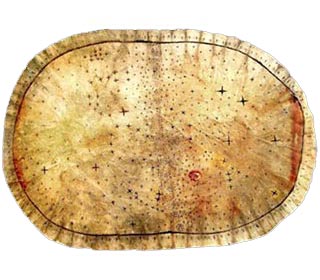The Pawnee believed that stars were deities who once lived on Earth and then were transformed into stars at death. Comets, meteorite showers and novas were viewed as omens of great disasters. The pictures depict a Pawnee Star Chart with clearly recognizable constellation patterns, as shown in the picture below. Instead of measuring the location of stars in order to calculate a location the Native Americans used the location of stars and constellations in the Star Chart & Astrology maps to signal seasons and events of the year. Star Chart & Astrology and the Shaman
The Star Chart & Astrology maps were used by the Shaman in preparation for an important ceremony or ritual, the position of stars indicated the proper timing of sacred ceremonies and spiritual rituals. These Star Charts, or Star Maps were used by a Medicine Man, or Shaman, and were included with many other sacred objects that they kept in their Medicine Bag. In their tribal beliefs the Milky Way was seen as a pathway to the afterlife. The stories, myths and legends relating to the heavens were recalled by the Shaman whose role included that of an educator and historian, the keeper of myths, legends, traditions and tribal wisdom. Star Chart & Astrology - Star Gazing
A dark night sky afforded the opportunity for star gazing when it was possible to behold various constellations and planets with the naked eye. These were studied by the star gazing Shaman as a form of communion with the night sky. The brightness of the stars and their prominent placements of the constellations seen in the night skies were important to increasing the sacred knowledge of the Shaman which he transferred to a Star Chart & Astrology map. The stars signalled times to plant crops and the position of the stars played an important mystic role in the everyday life of Native American Indians. Importance of the Star Chart & Astrology in the Everyday Lives of Native Americans
The Star Chart & Astrology maps not only served as a measurement of time but was perceived of such importance that many tribes reflected of the position of the stars in the way their camps and villages were laid out. This was a form of an earthly connection to the world of the heavens. The use of a Star Chart and astrology map played a significant role in the lives of the Skidi group of Pawnee Indians. The layout of the Pawnee villages adhered to the position of the most important stars in the sky: - The lodges in each village were arranged in a pattern that reflected specific star groupings
- The entryway to the lodges faced east to the rising sun
- The far east and far west points of the village had shrines to the morning star and the evening star
- The morning star is the brightest star in the sky at dawn. The morning star is actually the planet Venus as seen in the eastern sky around dawn
Star Chart & Astrology - Meteors and Bad Omens
All Native American Indian tribes believed that comets and meteorite showers were bad omens of great disasters. The Shamans of many tribes depicted a famous event that occurred took place on the morning of November 13, 1833, which is now called the Leonid meteor shower. This fantastic meteoric display and was was witnessed throughout North America and referred to as the 'Year the stars fell'. An interesting point of interest for those looking for information about the Native American star chart and astrology. | 